Robin_Usagani
TPF Noob!
Ever since I started shooting, I had never calibrated my monitor until recently. I always try to set my monitor close to my iphone and ipad. That seems to do the trick. I am not as concern about the color as much as the brightness/exposure. It always drives me nuts when I cc someone work and I tell them it is overexposed and they come back to me and say.. do you calibrate your monitor? Well guess what, do you rather have an image that looks correct on a "calibrated" screen, or do you rather have an image that looks correct on the most used mobile phone and tablet in the world?
Now I have a brand new laptop with non glossy screen, I decided to buy spyder color pro and calibrate it. IMO, my calibration vs iPhone and iPad (factory setting brightness level) is pretty dead on. If you are new to photography, I highly suggest my method. I even printed bunch of stuff at costco, they all look pretty close too.
Now that I have a calibrated monitor, which by the way look identical to my iphone and ipad, a few people just criticized my latest boudoir photos being overexposed. This got me thinking.. is buying a calibration tool really that worth it? So far I think it is a waste of money. Setting my monitor close to iphone and ipad is good enough IMO. Do I need to be THAT guy and reply back, "Do you have a calibrated monitor?". I don't even know anymore. All I know is this... my boudoir photos look good on MY monitor, MY iphone, My ipad and the album I printed . If you dont calibrate your monitor, I highly suggest comparing your monitor to factory setting apple devices.
. If you dont calibrate your monitor, I highly suggest comparing your monitor to factory setting apple devices.
Now I have a brand new laptop with non glossy screen, I decided to buy spyder color pro and calibrate it. IMO, my calibration vs iPhone and iPad (factory setting brightness level) is pretty dead on. If you are new to photography, I highly suggest my method. I even printed bunch of stuff at costco, they all look pretty close too.
Now that I have a calibrated monitor, which by the way look identical to my iphone and ipad, a few people just criticized my latest boudoir photos being overexposed. This got me thinking.. is buying a calibration tool really that worth it? So far I think it is a waste of money. Setting my monitor close to iphone and ipad is good enough IMO. Do I need to be THAT guy and reply back, "Do you have a calibrated monitor?". I don't even know anymore. All I know is this... my boudoir photos look good on MY monitor, MY iphone, My ipad and the album I printed







![[No title]](/data/xfmg/thumbnail/30/30890-45d8875af0c79f0f727d7d55132972b0.jpg?1619734501)

![[No title]](/data/xfmg/thumbnail/36/36396-f8e84def7352af726df923054b86284f.jpg?1619737549)



![[No title]](/data/xfmg/thumbnail/39/39187-9ec2507d9e5ef2843f7f00127c7abb4c.jpg?1619738905)
